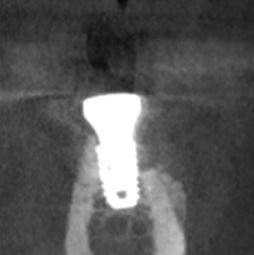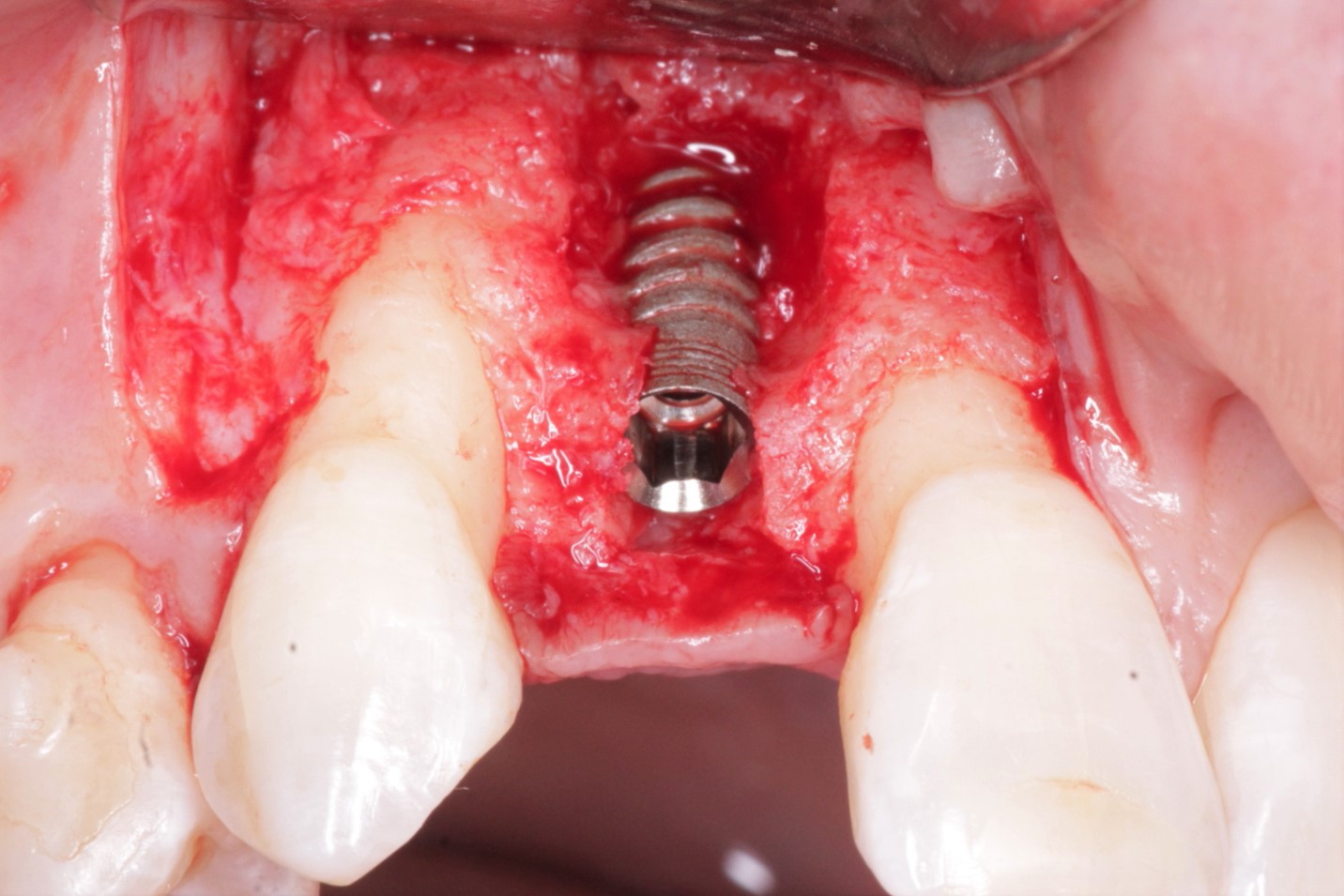To graft or to split?
I have a 20 year old female patient who had undergone extraction of bilateral mandibular first molars at the age of 13 following failed RCT. She now wants to replace with implants. Both second molars are tilted mesially. There is severe resorption. My question is whether to do a block graft , wait and place implants or to do a ridge split and and place implants?
I have had two different opinions from the surgeon (wants the graft) and the prosthodontist (wants the ridge split).
What do you recommend?












26 Comments on To graft or to split?
New comments are currently closed for this post.
Timothy C Carter
12/28/2018
Neither. There is plenty of native bone making both options unnecessary. At most it might require some particulate at the time of placement
rick
1/6/2019
I agree with Dr. Carter and use Versah to osseodensify the bone during placement and create some expansion. Then use particulate at time of placement with membrane.
Bear down
12/29/2018
I agree with Dr. Carter. No reason to put this patient thru a graft or ridge split. Assuming to place a 4.5 width diameter implant you should still be able to maintain at least 2mm of buccal bone. Other detail that is not shown is soft tissue. Many people who loose teeth and do not replace them for years usually have soft tissue deficiency. Just an opinion, but it would be a good idea for you to get more training in implants so specialist do not dictate your patients treatment options. In my experience, some specialist do always know better.
Joe Favia
12/31/2018
Based on the slices. I would place and graft on the buccal. If there was less bone available on the buccal, I would split.
Richard Hughes DDS
12/31/2018
I would expand the ridge at both sites. And recontoure the medial of the second molars. Ideally the second and third molars should be tipped distally. Place sliders over the sites at second stage surgery.
Carlos Boudet, DDS
12/31/2018
Richard, what are sliders? Thanks.
Dennis Flanagan DDS MSc
12/31/2018
This is a great case for an osteo-periosteal ridge split and expansion (Jensen) to maximize the facial bone thickness (need 2mm for a long-term successful result). This can probably done flaplessly with a #330 burr and D shaped osteotomes.
Dennis Flanagan DDS MSc DABOI/ID, FAAID, FAO, DABGD
Paul
12/31/2018
Judging from the size of the second molar, the space looks larger than a typical first molar in proportion to the second molar. If one places a single implant as is it may turn out that the molar will have to be contoured (emergence profile) in a way that it will become a food trap and make the young woman unhappy. Uprighting the second molar and creating proper ridge condition (splitting the ridge being a better choice) may be something to think about. Ridge splitting is more predictable, more successful than block grafting in that area (opinion based on experience).
Doc
12/31/2018
Do you have any images with a radiographic guide to see the future crown positions? I would get this first, and then decide on next steps.
Patient is young. I am seeing a lot of implant placement in young patients. I would consider waiting until 25 y.o.
Menachem Darwish
12/31/2018
Another option is to remove third molars ,orthodontically straighten the second molars and then do the implants. There appear to be enough bone though tunneling technique to augment is a possibility.
R Gangji DDS, AFAAID, FIC
12/31/2018
Osseodensification with densah burs would work here, as lots of cancellous bone to expand, maybe need buccal veneer graft, if you use a wider final fixture.Agree with food trap issue and patient should be informed that uprighting molars is ideal thing do do or recontour mesial of second molars to prosthetically help reduce some of the triangular food trap causing cervical space.
Soft tissue thickness will determine if fixture should be submerged a little.
Dr Dale Gerke - BDS,BScDe
12/31/2018
Happy New Year to all contributors and readers.
This case exemplifies why making decisions on too little information can be inappropriate.
Several CT sections/slices indicate there might be enough bone to do minimal work for implant placements (although getting optimum angulation could be a problem). Yet other slices seem to show nowhere near enough buccal bone. So this presentation is ambiguous and more information is required - eg intra and extra oral photos and models of the upper and lower dentitions. This seems to be confirmed because two specialists apparently have given conflicting thoughts on how to proceed (although there is nothing unusual about dentists having different ideas).
However the preliminary OPG seems to indicate that there are considerable dental alignment problems plus over eruption in the upper arch.
I would also like better slices showing where the IAN is positioned (I am not confident about this with what has been presented).
As well I would normally suggest that 20 years old is too young for implants to be placed.
With this in mind I would suggest that more diagnostic “work up” is required and at least an orthodontic consult should be arranged. When all details are considered, then I would expect several treatment options could be presented to the patient and she can select whatever suits her best (presumably taking into account: finances, time required, and relevant necessity for aesthetics and long term function).
Adam
1/1/2019
Well thought out response
LSDDDS
12/31/2018
If occlusion is intercusped, there are two functional molars and patient has no complaint
Why not leave it alone? Why restore at all?
Adam
1/1/2019
Why not think orthodontic treatment, bone plates canines and minimum anchorage and bring the molars forwards she has good wisdom teeth. If class II and protrusive there is a bombed premolar. Patients young so implants will fail in her lifetime at least once, then what. Also generally speaking cost is less for patient.
Andris
1/1/2019
I would graft it or if the available length allows for subcrestal implant placement with particulate xenograft augmentation - do it .
Edgar Davila, DDS, MS, CD
1/1/2019
Happy New Year to all ! The patient wants advise to replace her missing first molars. CBCT images are an important diagnostic tool but a diagnostic wax-up of the proposed restoration is equally important. For partially edentulous cases, proper Implant Planing Software (inVivo, Simplant, BlueSky Bio, Codiagnostix, Implant Studio, etc) can create a Virtual Wax-up of the missing teeth and combine it with STL digital models from an Intraoral Scanner (Omnicam, Trios, PlanMeca, Carestream, etc). Based on the wax-up, then the proper implant size and position (angulation, mesiodistal and buccolingual) is planned on available bone. Then a treatment plan decision is made to decide if the bone is adequate or there is a need to augment it. At the same time, digital models will help us to determine the need to recontour proximal surfaces of adjacent teeth, and also the need to adjust opposing dentition due to extrusion and create a better occlusal space, which appears to be inadequate in this case. I also agree that an orthodontic consultation is indicated to create a better treatment plan to explain to the patient.
Dr. Gerald Rudick
1/1/2019
I remember attending a lecture of the late-great Carl MIsch, when he would refer such a case to an orthodontist......whereby in this situation, the second molars could be properly aligned and dragged forward by using all the lower teeth banded and as a resistance force......when the second molars are moved mesially, they will have healthy buccal and lingual bone attached, and no grafting or implants will be necessary......
CRS
1/1/2019
Definately agree teeth need to be in optimal positions there is tipping in mandible and supra eruption in the maxillary teeth. This is a twenty year old patient go for optimal treatment instead of the fast buck placing the implants.
Dr. Gerald Rudick
1/1/2019
A further note to my above comment, is that naturally the third molars would as well be advanced forward ( mesial) and they would now become the second molars......
Paul
1/1/2019
The doctor who asked the question about graft or to split should have asked about the fundamental biological principles and differences that take place in one or the other approaches. My feeling is that there would be fewer replies and the issue would not be as confusing. Gut feelings should not dictate the approach to any procedure and dentists in the majority operate under that philosophy. Am I wrong?
Joseph Kim, DDS, JD
1/1/2019
Place both implants with guided bone regeneration on the buccal using xenograft, and making sure to perforate the buccal cortical plate in both edentulous spaces and close to the second molars. Have the patient undergo orthodontic therapy to upright the molars during the healing process, and use the implants to aid in movement after uncovery in 4 months. Total treatment time should be 6-12 months, rather than years to translate 4 molars an entire molar space mesially.
Greg Kammeyer, DDS, MS, D
1/2/2019
Having done a case or two like this, without the ortho >'d way too much food collecting/pt hated it!, Considering her age and that mandibular bone manipulation with either of these two modalities is less predictable than ortho, I'd get the ortho consult first.
Robert Wolanski
1/3/2019
This is also a case that demonstrates how we need to treatment plan differently depending on age. If the patient was 40- 50 years plus I would consider implants. Given how young she is I would definitely want to do orthodontics or at least consider the consult. if it was my daughter I would prefer orthodontics for all of the reasons those of us on the 30 year side of placing implants know. Having said that, orthodontics is not "easy" to do in these cases and selecting someone who is confident and experienced would be important. As time increases the orthodontic movement will only become more difficult.
oralsurgeryjj
1/4/2019
IF you just want implant without orthodontic alignment for 20 years old patient
I also would consider orthodontic Tx as priority.
But if implant without ortho is the only option....
First of all, ridge split in this kinda situation is quite difficult, since short M-D distance will yield minimum flexibility thus easy fracture, especially in mandible. Vertical drilling and a factor of young female's bone might give some success chance, but in case of failure, the cost of squaring it up will be quite high, including endangering adjacent teeth.
I do not suggest lingual placement of fixture with no bond graft also as buccal depression of prosthetics will incur food packing or plaque deposition fluid-dynamically.
I see that amount of defect as "semi-contained defect". Proximal eminent buccal bone with adjacent teeth is not that far away.
Just place implant with Ti-mesh or non absorbable membrane.
Robert Wolanski
1/10/2019
If you are newer to bone grafting I would hesitate advising Ti mesh. It is certainly a valid modality but sooo much more technique sensitive. I would really advise shadowing someone who is experienced with Ti mesh before working with it

















